- Clone
- HM47 (See other available formats)
- Regulatory Status
- RUO
- Workshop
- V cB017
- Other Names
- Mb-1, Iga, CD79
- Isotype
- Mouse IgG1, κ
- Ave. Rating
- Submit a Review
- Product Citations
- publications
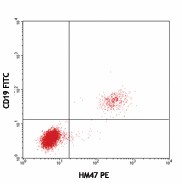
-

Human peripheral blood lymphocytes surface stained with CD19 (HIB19) FITC and intracellular stained with HM47 PE -

Multiplexed IHC staining of PE anti-CD79a (clone HM47) on formalin-fixed paraffin-embedded human tonsil tissue, validated for use on the Cellscape™. The tissue was iteratively stained with PE anti-CD79a (clone HM47, green) and PE anti-CD20 (red) for one hour at room temperature. Nuclei were counterstained with DAPI. Images were captured with a 20X objective. Scale bar: 50 µm
| Cat # | Size | Price | Quantity Check Availability | Save | ||
|---|---|---|---|---|---|---|
| 333503 | 25 tests | 95€ | ||||
| 333504 | 100 tests | 202€ | ||||
CD79a is a 47 kD type I integral membrane protein, also known as mb-1 or Iga. It is a member of the Ig superfamily and disulphide-associated with CD79b (B29). The interaction of CD79a/CD79b heterodimer with B cell suface Ig forms B cell antigen receptor complex. CD79a is expressed in B cells from early pre-B to plasma cell stage. It has been shown that CD79a is also weakly expressed in some precursors of T- and myeloid cells. CD79 mediates the transport of IgM to B cell surface and transduces signals initiated by BCR aggregation.
Product DetailsProduct Details
- Verified Reactivity
- Human
- Antibody Type
- Monoclonal
- Host Species
- Mouse
- Formulation
- Phosphate-buffered solution, pH 7.2, containing 0.09% sodium azide and BSA (origin USA)
- Preparation
- The antibody was purified by affinity chromatography, and conjugated with PE under optimal conditions.
- Concentration
- Lot-specific (to obtain lot-specific concentration and expiration, please enter the lot number in our Certificate of Analysis online tool.)
- Storage & Handling
- The antibody solution should be stored undiluted between 2°C and 8°C, and protected from prolonged exposure to light. Do not freeze.
- Application
-
ICFC - Quality tested
SB - Community Verified - Recommended Usage
-
Each lot of this antibody is quality control tested by intracellular immunofluorescent staining with flow cytometric analysis. For flow cytometric staining, the suggested use of this reagent is 5 µl per million cells in 100 µl staining volume or 5 µl per 100 µl of whole blood.
- Excitation Laser
-
Blue Laser (488 nm)
Green Laser (532 nm)/Yellow-Green Laser (561 nm)
- Additional Product Notes
-
For the use of this antibody in spatial biology (SB), we have partnered with Bruker Spatial Biology Biosciences for demonstration of this antibody on their next-generation ChipCytometry instrument called the CellScape™. The CellScape platform is an end-to-end solution for highly multiplexed spatial omics. Combining an advanced, purpose-built imaging system with easy-to-use fluidics for walk-away automation, the CellScape system will accelerate your exploration into the rapidly evolving field of spatial biology. More information on the the Bruker Spatial Biology CellScape and a complete list of our antibodies that have been demonstrated on the instrument can be found here.
- Product Citations
-
- RRID
-
AB_1089076 (BioLegend Cat. No. 333503)
AB_1089073 (BioLegend Cat. No. 333504)
Antigen Details
- Structure
- 47 kD, type I integral protein, Ig superfamily, CD79a/CD79b heterodimer interacts with B cell membrane Ig.
- Distribution
-
B cells (from early pre-B to plasma cell stage), some T and myeloid cell precursors
- Function
- In association with CD79b and B cell membrane Ig to form B cell antigen receptor complex
- Cell Type
- B cells, Hematopoietic stem and progenitors
- Biology Area
- Immunology
- Molecular Family
- CD Molecules
- Antigen References
-
1. Zola Heddy, et al. Eds. 2007. Leukocyte and Stromal Cell Molecules:The CD markers. WILEY-LISS
2. Astsaturov IA, et al. 1996. Leukemia 10:769
3. Mson DY, et al. 1995 Blood 86:1453
4. Hashimoto M, et al. 2002. J. Pathol. 197:341 - Gene ID
- 973 View all products for this Gene ID
- UniProt
- View information about CD79a on UniProt.org
Related FAQs
- What type of PE do you use in your conjugates?
- We use R-PE in our conjugates.
- If an antibody clone has been previously successfully used in IBEX in one fluorescent format, will other antibody formats work as well?
-
It’s likely that other fluorophore conjugates to the same antibody clone will also be compatible with IBEX using the same sample fixation procedure. Ultimately a directly conjugated antibody’s utility in fluorescent imaging and IBEX may be specific to the sample and microscope being used in the experiment. Some antibody clone conjugates may perform better than others due to performance differences in non-specific binding, fluorophore brightness, and other biochemical properties unique to that conjugate.
- Will antibodies my lab is already using for fluorescent or chromogenic IHC work in IBEX?
-
Fundamentally, IBEX as a technique that works much in the same way as single antibody panels or single marker IF/IHC. If you’re already successfully using an antibody clone on a sample of interest, it is likely that clone will have utility in IBEX. It is expected some optimization and testing of different antibody fluorophore conjugates will be required to find a suitable format; however, legacy microscopy techniques like chromogenic IHC on fixed or frozen tissue is an excellent place to start looking for useful antibodies.
- Are other fluorophores compatible with IBEX?
-
Over 18 fluorescent formats have been screened for use in IBEX, however, it is likely that other fluorophores are able to be rapidly bleached in IBEX. If a fluorophore format is already suitable for your imaging platform it can be tested for compatibility in IBEX.
- The same antibody works in one tissue type but not another. What is happening?
-
Differences in tissue properties may impact both the ability of an antibody to bind its target specifically and impact the ability of a specific fluorophore conjugate to overcome the background fluorescent signal in a given tissue. Secondary stains, as well as testing multiple fluorescent conjugates of the same clone, may help to troubleshoot challenging targets or tissues. Using a reference control tissue may also give confidence in the specificity of your staining.
- How can I be sure the staining I’m seeing in my tissue is real?
-
In general, best practices for validating an antibody in traditional chromogenic or fluorescent IHC are applicable to IBEX. Please reference the Nature Methods review on antibody based multiplexed imaging for resources on validating antibodies for IBEX.
Other Formats
View All Reagents Request Custom Conjugation| Description | Clone | Applications |
|---|---|---|
| Purified anti-human CD79a (Igα) | HM47 | ICFC,IHC-P,IP,WB |
| PE anti-human CD79a (Igα) | HM47 | ICFC,SB |
| APC anti-human CD79a (Igα) | HM47 | ICFC |
| PerCP/Cyanine5.5 anti-human CD79a (Igα) | HM47 | ICFC |
| PE/Cyanine7 anti-human CD79a (Igα) | HM47 | ICFC |
| FITC anti-human CD79a (Igα) | HM47 | ICFC |
| Alexa Fluor® 594 anti-human CD79a (Igα) | HM47 | IHC-P |
| Alexa Fluor® 647 anti-human CD79a (Igα) | HM47 | ICFC,IHC-P |
| APC anti-human CD79a | HM47 | ICFC |
| PerCP/Cyanine5.5 anti-human CD79a | HM47 | ICFC |
| PE anti-human CD79a | HM47 | ICFC |
| FITC anti-human CD79a | HM47 | ICFC |
| TotalSeq™-B0578 anti-human CD79a (Igα) | HM47 | ICPG |
| GMP PerCP/Cyanine5.5 anti-human CD79a (Igα) | HM47 | ICFC |
| Brilliant Violet 421™ anti-human CD79a (Igα) | HM47 | ICFC |
| GMP APC anti-human CD79a (Igα) | HM47 | ICFC |
| TotalSeq™-C0578 anti-human CD79a (Igα) Antibody | HM47 | ICPG |
Customers Also Purchased


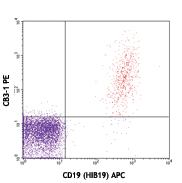
Compare Data Across All Formats
This data display is provided for general comparisons between formats.
Your actual data may vary due to variations in samples, target cells, instruments and their settings, staining conditions, and other factors.
If you need assistance with selecting the best format contact our expert technical support team.
-
Purified anti-human CD79a (Igα)
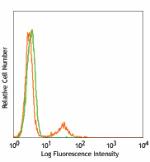
Human peripheral blood lymphocytes intracellularly stained w... 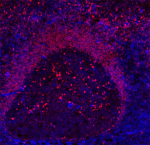
Human paraffin-embedded tonsil tissue slices were prepared w... -
PE anti-human CD79a (Igα)
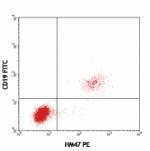
Human peripheral blood lymphocytes surface stained with CD19... 
Multiplexed IHC staining of PE anti-CD79a (clone HM47) on fo... -
APC anti-human CD79a (Igα)
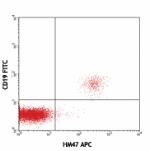
Human peripheral blood lymphocytes surface stained with CD19... -
PerCP/Cyanine5.5 anti-human CD79a (Igα)

Human peripheral blood lymphocytes surface stained with CD19... -
PE/Cyanine7 anti-human CD79a (Igα)

Human peripheral blood lymphocytes were stained with CD19 Br... -
FITC anti-human CD79a (Igα)
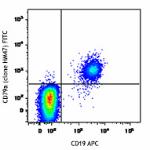
Human peripheral blood lymphocytes were stained with CD19 AP... 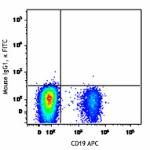
-
Alexa Fluor® 594 anti-human CD79a (Igα)
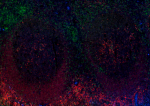
Human paraffin-embedded tonsil tissue slices were prepared w... -
Alexa Fluor® 647 anti-human CD79a (Igα)

Human peripheral blood lymphocytes surface stained with CD19... 
Human paraffin-embedded tonsil tissue slices were prepared w... -
APC anti-human CD79a
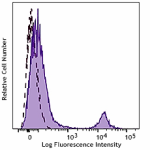
Typical results from human peripheral blood lymphocytes were... -
PerCP/Cyanine5.5 anti-human CD79a
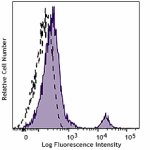
Typical results from human peripheral blood lymphocytes fixe... -
PE anti-human CD79a
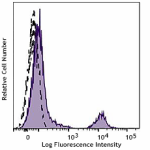
Typical results from human peripheral blood lymphocytes were... -
FITC anti-human CD79a
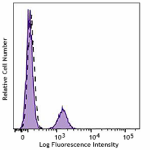
Typical results from human peripheral blood lymphocytes fixe... -
TotalSeq™-B0578 anti-human CD79a (Igα)
-
GMP PerCP/Cyanine5.5 anti-human CD79a (Igα)

Typical results from human peripheral blood lymphocytes fixe... -
Brilliant Violet 421™ anti-human CD79a (Igα)

Human peripheral blood lymphocytes were surface stained with... -
GMP APC anti-human CD79a (Igα)

Typical results from human peripheral blood lymphocytes were... -
TotalSeq™-C0578 anti-human CD79a (Igα) Antibody
 Login / Register
Login / Register 










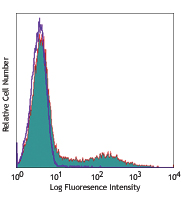



Follow Us